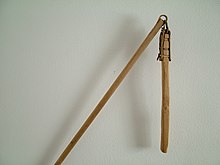Threshing
[6] This method, however, damaged part of the grain, and it was partially superseded by the threshing sledge, a heavy frame mounted with three or more rollers, sometimes spiked, which revolved as it was drawn over the spread out corn by two oxen.
It was known in Japan very early, and was probably used in conjunction with the stripper, an implement fashioned very much like a large comb, with the teeth made of hard wood and pointing upwards.
[5] After the grain had been beaten out by the flail or ground out by other means the straw was carefully raked away and the corn and chaff collected to be separated by winnowing when there was a wind blowing.
The flail continued to be used for special purposes such as flower seeds, and also where the quantity grown was small enough to render it not worth while to use a threshing mill.
He invented what was described as a "rotary machine consisting of a set of cross arms attached to a horizontal shaft and enclosed in a cylindrical case."
This cylinder or "drum" was armed with four iron-shod beaters or spars of wood parallel to its axle, and these striking the ears of corn as they protruded from the rollers knocked out the grain.
[5] A later development of the beater-drum was to fix iron pegs on the framework, and thus was evolved the Scottish "peg-mill," which remained the standard type for nearly a hundred years, and was adopted across the US.
[5] In Britain, the development of high-speed drums carried considerable risk, and a type of safety guard was mandated by the Threshing Machine Act of 1878.
The original purpose has largely become obsolete, but the festival tradition lives on in some modern examples that commemorate the past and include flea markets, hog wrestling, and dances.


